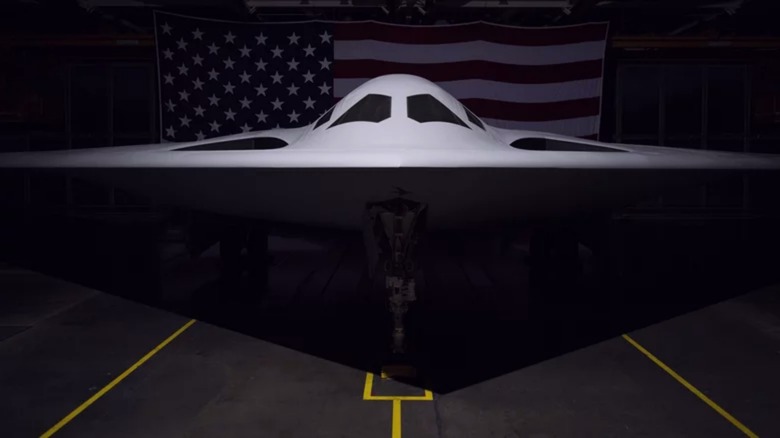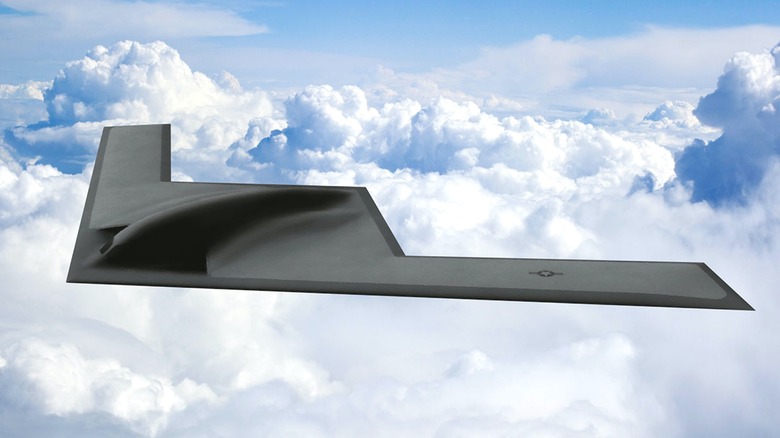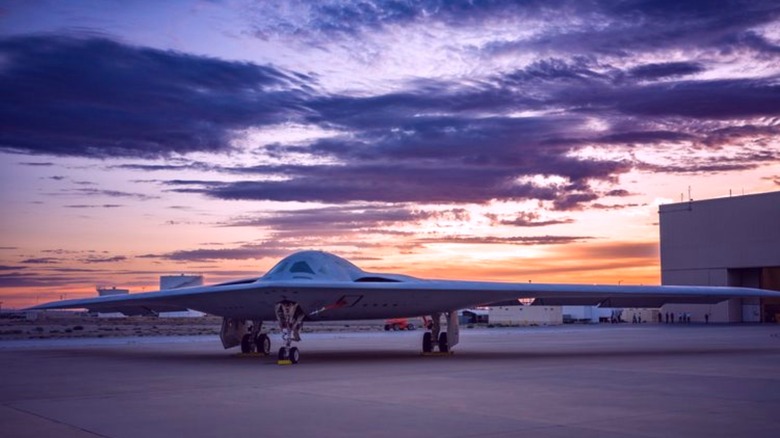How Northrop Grumman's B-21 Raider Changes The Landscape Of Air Power
In November 2023, Northrop Grumman, working with the U.S. Air Force, flew the newly developed B-21 Raider for the first time. The new Long Range Strike Bomber is a ways from completion. Still, its introduction in 2022 and flight the following year reveals several design characteristics that suggest it won't merely replace the B-52 Stratofortress, B-1 Lancer, and B-2 Spirit; it will change the landscape of air power altogether.
Of course, almost everything of interest about the B-21 is highly classified. The bomber will replace the Air Force's fleet of intercontinental strategic bombers, and its technology requires a level of security to remain effective. Despite this, some information is available — the Air Force and Northrop Grumman show how this new airborne platform will be able to deliver both conventional and thermonuclear payloads anywhere around the world.
The B-21 Raider is planned to enter active service midway through the 2020s and will replace its predecessors by 2040. Over the next decade, additional details may come out about some of the design elements, but what we know now makes it clear that the B-21 Raider will alter strategic air planning. It's not only capable of flying with the latest in stealth technology, but it also functions autonomously and offers support to manned and unmanned aerial operations.
The B-21 abandons analog tech for a fully functional digital platform
One of the most significant innovations the B-21 brings is its deployment of digital technology. While older U.S. Air Force bombers have been upgraded and retrofitted many times, some platforms are decades old, and a full replacement will help modernize the service's fleet.
The B-21 can be flown manned or controlled remotely, making it the first intercontinental strategic bomber capable of carrying nuclear bombs without a pilot. The B-21 also has many of the same remote-operational capabilities as the MQ-1 Predator and other unmanned aerial vehicles. Granted, a qualified pilot will still need to fly the aircraft, but they can do so from the comfort of their home installation in the United States or at a forward operating base set up elsewhere. This marks a significant boost forward in semi-autonomous strategic flight operations.
Stealth technology has also advanced greatly since the Air Force first kitted the F-117 Nighthawk with it in 1983. Since then, it has become more advanced and significantly cheaper. The B-21's stealth technology, coupled with its capability to operate as both a strategic bomber and intelligence, surveillance, and reconnaissance (ISR) aircraft, means it will be able to provide maximum support across myriad operations.
Trading size for functionality
The B-21 uses a similar airframe and technology to the B-2, but it's vastly different in many ways. It's wingspan is 132 feet, 40 shorter than the B-2. And the price is significantly different, as the B-2 cost approximately $1.157 billion per aircraft (in 1999 dollars). The projected cost of the B-21 is $692 million, and the Air Force plans to order 100 of them. The reduced size and decreased cost likely indicate that operation and maintenance costs will be reduced.
One key difference between the B-21 and B-2 is the payload. With a smaller airframe, the B-21 can carry a payload of 30,000 lbs. while the B-2 could carry twice as much. All told, the USAF only ordered 21 B-2s, and while the B-2 has functioned well during combat operations, its cost to procure and maintain, not to mention the training for pilots, ensured the Air Force used it sparingly.
Ultimately, this new sixth-generation bomber is the culmination of more than 70 years of innovation in strategic bomber technology and operations. Its full functionality and capabilities will remain secret for quite some time. Still, everything Northrop Grumman and the Air Force released indicates the new aircraft will be formidable in the skies worldwide when it fully enters service.


